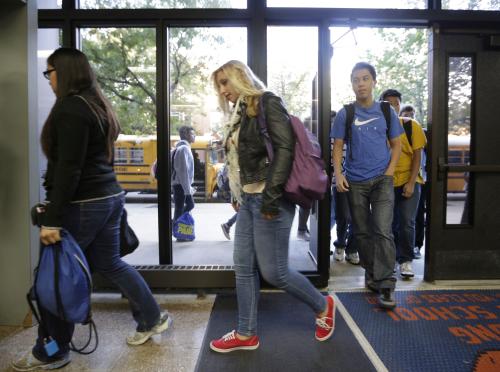School segregation is capturing headlines, due to a heated exchange between Sen. Kamala Harris and former Vice President Joe Biden in a recent Democratic primary debate. While the benefits of racially integrated schools are clear, the legal and political hurdles to achieving racial diversity are substantial. Legally, the U.S. Supreme Court has expressed profound skepticism of districts considering a student’s race when making school assignments. Politically, integration efforts have proven to be a tough sell to communities, a reality illustrated by the fact that hundreds of districts have sought release from desegregation orders over the past few decades.
So what’s a district to do when it wants its students to accrue the benefits of racially diverse schools but a racial integration initiative is off the table? More than 100 districts and charter school networks have decided that the answer to this question is to integrate schools on the basis of socio-economic status (SES), with the hopes that racial diversity will follow. Such an approach could make sense. It skirts the constitutional questions that accompany race-based integration initiatives while holding the promise of greater political palatability. But do these SES-based school assignment policies ultimately achieve the racial integration that districts are looking for?
This is the question that motivates a recent paper of ours in which we use data from the Wake County Public School System (WCPSS) to measure just how much racial diversity the district got from their SES-based school assignment policy. In particular, we compare racial segregation levels across district schools under the district’s SES-based assignment policy to the racial segregation levels that would have resulted if all students attended their neighborhood school. We can only make this comparison because of the great data that WCPSS keeps—information not only on the school that each student attends, but also on the school each student would have attended under a pure residence-based assignment regime.
Background on school integration efforts in Wake County, N.C.
Before turning to our results, we should provide a little context on WCPSS. Serving more than 160,000 students, WCPSS is the largest school district in the state of North Carolina and the 16th-largest district in the country. The racial and ethnic makeup of WCPSS has long been broadly representative of North Carolina as a whole, with both the state and district currently serving a student body that is about half white, 25% black, and just less than 20% Hispanic. With this longstanding diversity comes a history of segregation. Unlike many Southern districts, though, WCPSS has a long history of voluntary integration efforts, including a race-based busing initiative employed throughout much of the 1980s and all of the 1990s. In the late 1990s, district leadership began to fear that their race-based school assignment policy would be ruled unconstitutional—a fear that ultimately proved well-founded—so in the 2000-01 school year they switched to SES-based school integration. Under this policy, the district set a target of no school having more than 40% of its student body eligible for free or reduced-price lunch and no more than 25% of students performing below grade level.
To meet these targets, WCPSS started by assigning each student to a neighborhood school, but then used several strategies to achieve the desired balance across schools. First, and most visibly, the district would reassign some students away from their neighborhood schools to other schools in the district. Although this aspect of WCPSS’ assignment system generated the most controversy, it affected a relatively small number of students, typically only 5-10% annually. Second, the district operated a set of magnet schools, many of which it located in disadvantaged neighborhoods with an eye toward attracting relatively affluent families. Third, WCPSS operated a number of year-round schools in a manner that helped the district meet its integration targets.
Research shows that, together, these strategies did lead to a noticeable decline in socio-economic segregation throughout the early 2000s. And although a change in school board composition—the result of a contentious election—brought an end to WCPSS’s SES-based assignment policy in 2010, it remains notable that the district aggressively worked to integrate its schools for more than 25 years.
The effects of Wake County’s SES-based integration efforts
So, with this context in mind, what do we find? Did the SES-based school assignment policy result in greater levels of racial integration?
Well, the story is a bit complicated. On one hand, on average, racial and ethnic segregation levels were not meaningfully different under the SES-based assignment policy compared to a scenario in which all students would have attended their neighborhood school. For example, over the time period we study, the average black student attended a school where 46.5% of students were white. If all students had attended their neighborhood school, the average black student would have attended a school where 45.8% of students were white, a number that is slightly lower but not meaningfully different from segregation levels under the SES-based assignment policy.
On the other hand, for students who would have attended majority-minority schools under residence-based school assignment, the SES-based assignment policy dramatically changed their schooling context. For example, in schools where 75% of the student body would have been nonwhite under a residence-based school assignment policy, the average black student would have attended a school where only 14.3% of students were white. Under the SES-based assignment policy, they attended a school where 37.5% of students were white—a considerably more diverse school environment.
Implications for policy
What can we take away from this? What can policymakers and practitioners learn? We see three important lessons. First, WCPSS’ experience shows that it is possible to design a districtwide SES-based school assignment policy that has little effect on overall racial and ethnic segregation levels in the district, but dramatically reduces segregation levels for students who would have attended majority-minority schools under a residence-based school assignment regime. Political realities often result in broad-based policies bestowing educational benefits on advantaged student populations while doing little to change the schooling contexts of their less advantaged peers. WCPSS’ school assignment policy arguably did just the opposite. Still, the fact that overall racial and ethnic segregation levels remained relatively unchanged illustrates just how hard it is to achieve broad-based racial integration without pursuing it directly.
Second, regardless of whether one deems the SES-based assignment policy a success or not, WCPSS’ experience illustrates the importance of taking advantage of all possible levers in an effort to achieve integration targets. Use the appeal of magnet schools. Leverage family demand for year-round schooling. Involuntarily reassign students if it comes down to that. The WCPSS case makes clear that an “all of the above” strategy is almost certainly necessary if districts are going to even have a chance to achieve meaningful integration.
Third, any integration initiative is ultimately a balancing act between achieving meaningful diversity and navigating the politics of this issue. Magnet schools are politically popular, but they might just push segregation down to the classroom level. Involuntary reassignments can generate meaningfully diverse schools and classrooms, but the political blowback is often immense. WCPSS’ experience illustrates just how precarious this balancing act can be. Even a district with a storied history of diversity efforts ultimately fell victim to the political realities surrounding integration. This doesn’t mean that districts shouldn’t try to help their students accrue the benefits of diverse schools, just that each district going down the integration road will need to figure out the approach for walking this tightrope that works best for them.
The Brookings Institution is committed to quality, independence, and impact.
We are supported by a diverse array of funders. In line with our values and policies, each Brookings publication represents the sole views of its author(s).









Commentary
Can school districts achieve racial integration by pursuing socio-economic integration?
July 15, 2019